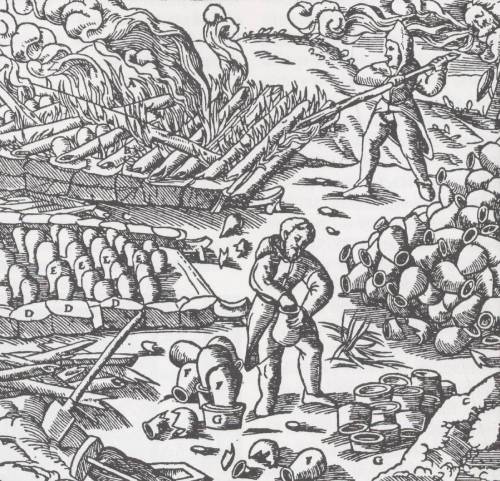Although the well-researched and studied technical heritage of the mercury mine provides valuable information, the project activities, especially the exploration of smelting sites and the discovery of remains of old smelting furnaces, will contribute important data for the preservation and development of cultural heritage in terms of sustainable development, improved accessibility, and the creation of conditions for new jobs through further development of cultural tourism.

Project partners: CUDHg Idrija, Avgusta d.o.o., ICRA d.o.o. Idrija
Project duration: 01. 01. 2020 – 30. 04. 2021
Project background: While the technical heritage of the mercury mine has been extensively researched and studied, the project aims to contribute valuable data for the preservation and development of cultural heritage. Specifically, the project focuses on the exploration of smelting sites and the discovery of remains of old smelting furnaces. This research will facilitate sustainable development, improved accessibility, and the creation of new job opportunities through the further development of cultural tourism.
The operation aims to support the research and protection of cultural heritage, develop content related to heritage, and enhance interpretation, presentation, and offerings. The remains of the old smelting furnaces provide important information about the necessary conditions and methodology for extracting mercury during the first hundred years of operation of the Idrija mine. They also reveal technological parameters for the extraction, preparation, transportation, and smelting of ore, offering insights into the technical and technological conditions of the Idrija mine in the 16th century. The documentation prepared as part of this project will facilitate the registration of the smelting furnaces in the Register of Cultural Heritage of the Republic of Slovenia, particularly in the section dedicated to immovable heritage. Furthermore, the project involves creating documentation to develop the smelting furnaces as a tourist attraction and to establish content for an open-air museum showcasing the 16th-century smelting furnaces.
Funding Source:
The project is funded by the European Agricultural Fund for Rural Development as part of the Local Development Strategy of the municipalities of Logatec, Idrija, and Cerkno in 2018 (LAS s CILjem)
CUDHg Idrija is responsible for the project's content, and the Ministry of Agriculture, Forestry, and Food is the managing authority for implementing the Rural Development Programme of the Republic of Slovenia for the period 2014-2020.
For more information about it, visit the European Commission's website: https://ec.europa.eu/agriculture/rural-development-2014-2020_sl and PRP website https://www.program-podezelja.si/sl/.
Discovering the Smelting Furnaces - research presentation
Wednesday, 30 September 2020, Hg Smelting plant at 18:00
As part of the Discovering the Smelting Furnaces project, a survey and examination of areas where ore was smelted in the 16th and 17th centuries have been conducted. We invite you to a research presentation where experts from various fields will share new findings and insights. The speakers include Dr. Jože Čar, Rafael Bizjak, Janez Rupnik, Janko Proj, Ernesta Drole, and Kristina Seljak.
The program will be moderated by Kristina Seljak, a expert associate on the Discovering the Smelting Furnaces project. In addition to presenting the work done so far in documenting the smelting areas, she will discuss future plans.
Dr. Jože Čar will explain the conditions in the mine that allowed 150 years of smelting in the surrounding forests. He will describe the establishment of smelting furnaces at specific locations and the preparations involved.
Rafael Bizjak will enhance the presentation with maps and illustrations, highlighting the entire process from ore excavation to smelting. He will discuss the Bašerija, a washing facility at Ahacijev trg, and present Ahacijev trg's appearance during that time. He will delve into the ore enrichment process, including excavation, sorting, ore preparation for smelting, quantities involved, yields and losses, mercury extraction, smelting residue, fuel consumption calculations (wood), and cleared smelting areas. He will also explain the location of smelting furnaces, transportation routes, and the methods of transporting ore, mercury, and retorts.
Archaeologist Janez Rupnik will provide an introduction to industrial archaeology and focus on assessing the archaeological potential of the smelting furnaces and their current state. He will present the results of exploratory excavations and geophysical surveys at three smelting sites, the typology of ceramics found at the smelting areas, and plans for future research and protection of the smelting furnaces.
Given the significance of retorts in the smelting process, we cannot overlook them. Well-preserved retorts were found in Bitnje near Škofja Loka in 1937. Therefore, we have invited Janko Proj to speak on the production of retorts and the potters of Škofja Loka from his professional perspective as a potter.
Ernesta Drole from the Institute for the Protection of Cultural Heritage of Nova Gorica will participate to discuss the smelting areas' inclusion in the tangible cultural heritage inventory. As the smelting furnaces do not yet have heritage status, she will explain the process of documenting and assessing heritage in the conservation profession. The conservator uses evaluation criteria to assess whether an object meets the requirements for heritage status.
This event will bring together experts from various fields, providing visitors with multiple perspectives on the smelting furnaces. Our goal is to raise awareness of the smelting furnaces and their importance in the mining tradition of Idrija.
